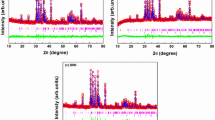Summary
-
1.
On the basis of their absorption spectra in the 400–1700 cm−1 region the borates studied can be divided into two groups: those in which the anion is an isolated (BO3 −3 triangle (kotoite, ludwigite), and those with complex anions (the other borates studied).
-
2.
The spectra of all the group of minerals from ascharite to borax are similar in the 400–1700 cm−1 region: this demonstrates the presence of common structural elements in all these minerals.
-
3.
Comparison of the absorption frequencies of the different groups of minerals shows that for interpretation of the structure of anions in polyborate minerals their hydrates and not anhydrous forms must be considered; i.e., the main structural units in polyborates are built up from BO3 triangles and BO4 tetrahedrons in which oxygen atoms are often replaced by hydroxyl groups.
-
4.
Weakly bound hydroxyls are present in the structures of ascharlte, colemanite, hydroboracite, and boronatrocalcite (absorption maximum at 3590 cm−1); hydroxyl interaction is stronger in inyoite, and hydroxyl bonding is complete in borax. Several degrecs of perturbation of the hydroxyl vibrations are found in pandermite; this indicates the presence of hydrogen bonds of different strengths. All polyborates give a characteristic broad and diffuse absorption band in the 2900–3600 cm−1 region, similar to the band given by boric acid (where the presence of hydrogen bonds has been proved).
Similar content being viewed by others
Literature Cited
T. A. Sidorov and N. N. Sobolev, Optika i spektroskopiya,1, 3, 353 (1956).
T. A. Sidorov and N. N. Sobolev, Optika i spektroskopiya,4, 1, 9 (1958).
F. A. Miller and C. H. Wilkins, Anal. Chem.,24, 1253 (1952).
D. E. Bethel and N. Sheppard, Trans. Faraday Soc.,51, 9 (1955).
V. Takeuchi, Min. Journ. Japan,2, 4, 245 (1958).
A. V. Nikolaev, Physicochemical Studies of Native Borates [in Russian], Izd. AN SSSR, M.-L., (1947).
A. D. Keshan, “Problems of borate chemistry.” Paper at the conference on borate chemistry, pp. 13–28 in the book: Borate Chemistry [in Russian], Izd. AN LatvSSR, Riga (1953).
Proceedings of Conference on the Chemistry of Boton and Its Compounds [in Russian], p. 19, Goskhimizdat, M., (1958).
Vl. N. Sobolev, Min. sb. L'vovsk. geol. obshch.,3, 227 (1949).
A. G. Betekhin, Mineralogy [in Russian], Gos. izd. geol. lit., M., (1950).
Carl V. F. Pistorius, J. Chem. Phys.,31, 1454 (1959).
M. V. Akhmanova, Usp. khimii,28, 3, 314 (1959).
N. V. Belov, Zh. strukt. khimii,1, 1, 39 (1960).
Author information
Authors and Affiliations
Additional information
Translated from Zhurnal Strukturnoi Khimii, Vol. 3, No. 1, pp. 28–34, January–February, 1962.
Rights and permissions
About this article
Cite this article
Akhamanova, M.V. Investigation of the structure of native borates by infrared absorption spectroscopy. J Struct Chem 3, 24–29 (1962). https://doi.org/10.1007/BF00745373
Received:
Issue Date:
DOI: https://doi.org/10.1007/BF00745373




